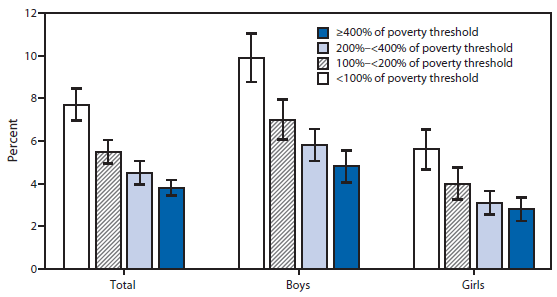QuickStats: Percentage* of Children and Adolescents Aged 4–17 Years with Serious Emotional or Behavioral Difficulties,† by Poverty Status§ and Sex — National Health Interview Survey, 2011–2014¶

* With 95% confidence intervals indicated with error bars.
† Emotional or behavioral difficulties of children were based on parents' responses to the following question: "Overall, do you think that (child) has any difficulties in one or more of the following areas: emotions, concentration, behavior, or being able to get along with other people?" Response options were 1) "no"; 2) "yes, minor difficulties"; 3) "yes, definite difficulties"; and 4) "yes, severe difficulties." Children whose parents' responded "yes, definite difficulties" or "yes, severe difficulties" were defined as having serious emotional or behavioral difficulties. These difficulties may be similar to but do not equate with the federal definition of serious emotional disturbance.
§ Poverty status is based on family income and family size using the annually updated U.S. Census Bureau poverty thresholds. Family income was imputed when missing.
¶ Estimates are based on household interviews of a sample of the civilian noninstitutionalized U.S. population and are derived from the National Health Interview Survey's Sample Child component.
During 2011–2014 the percentage of children with serious emotional or behavioral difficulties was about twice as high among children living in poor families (<100% of the poverty threshold) compared with children living in the most affluent families (≥400% of the poverty threshold) (7.7% versus 3.8%). This pattern was found for both boys (9.9% versus 4.8% ) and girls (5.6% versus 2.8%). At each poverty status level a higher percentage of boys than girls had serious emotional or behavioral difficulties.
Source: National Center for Health Statistics, CDC. National Health Interview Survey. Available at http://www.cdc.gov/nchs/nhis.htm.
Reported by: Cynthia Reuben, MA, creuben@cdc.gov, 301-458-4458; Patricia Pastor, PhD.
Alternate Text: The figure above is a bar chart showing that during 2011-2014 the percentage of children with serious emotional or behavioral difficulties was about twice as high among children living in poor families (<100% of the poverty threshold) compared with children living in the most affluent families (≥400% of the poverty threshold) (7.7% versus 3.8%). This pattern was found for both boys (9.9% versus 4.8%) and girls (5.6% versus 2.8%). At each poverty status level a higher percentage of boys than girls had serious emotional or behavioral difficulties.
Use of trade names and commercial sources is for identification only and does not imply endorsement by the U.S. Department of
Health and Human Services.
References to non-CDC sites on the Internet are
provided as a service to MMWR readers and do not constitute or imply
endorsement of these organizations or their programs by CDC or the U.S.
Department of Health and Human Services. CDC is not responsible for the content
of pages found at these sites. URL addresses listed in MMWR were current as of
the date of publication.
All MMWR HTML versions of articles are electronic conversions from typeset documents.
This conversion might result in character translation or format errors in the HTML version.
Users are referred to the electronic PDF version (http://www.cdc.gov/mmwr)
and/or the original MMWR paper copy for printable versions of official text, figures, and tables.
An original paper copy of this issue can be obtained from the Superintendent of Documents, U.S.
Government Printing Office (GPO), Washington, DC 20402-9371;
telephone: (202) 512-1800. Contact GPO for current prices.
**Questions or messages regarding errors in formatting should be addressed to
mmwrq@cdc.gov.


